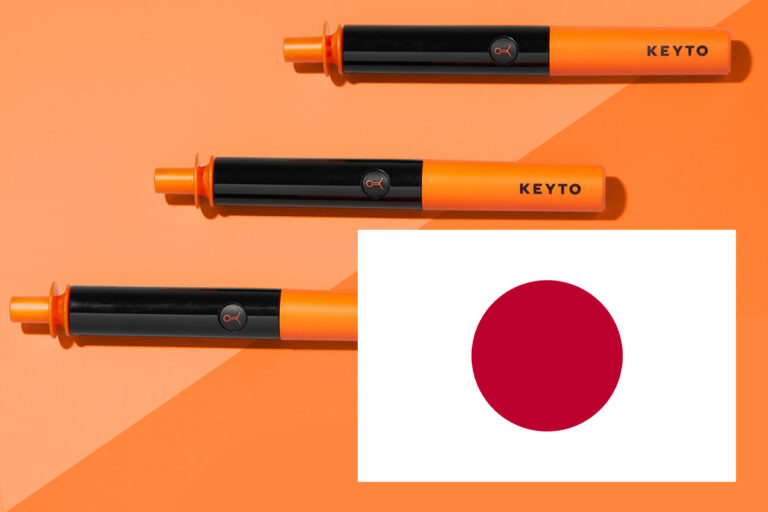What is a Ketone Breath Meter? 2024 (Fast & Convenient)

Checking your ketone levels is like keeping an eye on your gas gauge. If you’re on a keto diet or if you have diabetes, it’s crucial.
And a ketone breath meter is the fastest and most convenient way to measure your ketone levels.
It helps you to see if your body is burning fat for fuel, which is what you want.
If the levels are too high, it could be dangerous, like running a car on an almost empty tank. So, keep your body’s engine in check by monitoring your ketone levels regularly.
- What is a Ketone Breath Meter?
- How Does a Ketone Breath Meter Work?
- Understanding Ketosis
- Types of Ketone Bodies
- Types of Ketone Measurement
What is a Ketone Breath Meter?
A ketone breath meter is a handy device that measures the level of ketones in your breath, helping you know if your body is in a state of ketosis. It works by detecting acetone, a type of ketone your body produces when burning fat for energy.
This device uses a breath sensor for the analysis, making it easy and convenient to use. One major benefit is that it’s non-invasive and can be used multiple times.
However, a drawback is that it may not be as accurate as blood tests. Nevertheless, a ketone breath meter can be a useful tool for those following a ketogenic diet.
How Does a Ketone Breath Meter Work?
A ketone breath meter works by measuring the amount of acetone in your breath, which it shows as parts per million (PPM). This measurement tells your approximate level of ketosis or how much fat your body is burning. (6)
Measuring breath acetone levels is a type of breath diagnostics commonly used during the ketogenic diet. When you’re on a ketogenic diet, your body switches from burning glucose to burning fat for energy.
This process, called ketosis, produces a byproduct known as acetone. Unlike other ketone bodies, acetone is so small that it can escape from your body through your breath, which you can measure.
Research suggests that breath acetone concentration (BrAce) correlates with the rate of fat loss in healthy individuals. A breath acetone meter is a non-invasive way to check if your body is burning fat for energy.
Understanding Ketosis
Ketosis is a metabolic state where your body uses fat, instead of glucose, for energy. It’s relevant to those on a ketogenic diet, a low-carb diet that triggers this fat-burning process. (1)
When you limit your intake of carbs, your body starts to burn fat, entering a state of ketosis. This is why folks on keto diets are keen to know if they’re in ketosis.
It’s a sign that their body is burning fat effectively, which can lead to weight loss.
In addition, being in nutritional ketosis can also result from fasting, another method to reduce glucose and encourage the body to burn fat.
Types of Ketone Bodies
Ketone bodies are chemicals that our bodies produce when we don’t have enough insulin in our blood. Our bodies use them as an alternative energy source. They are produced from fat to be used as fuel by our bodies. There are three types of ketone bodies: acetoacetate, beta-hydroxybutyrate, and acetone. (2)
- Acetoacetate is the first ketone body that’s formed from fatty acids. It plays a key role in providing energy to our body, especially during fasting or strenuous exercise.
- Beta-Hydroxybutyrate (BHB) is actually not a true ketone body due to its structure, but it’s often classified as one. It forms from acetoacetate in our liver and is the most abundant ketone in our blood.
- Acetone is the least abundant and the simplest ketone body. It forms by the spontaneous breakdown of acetoacetate and is mostly exhaled through our breath.
Among these, acetone can be detected without any tools because it gives our breath a fruity smell. To measure acetoacetate and beta-hydroxybutyrate levels in the blood, we need either urine strips or a blood ketone meter.
Types of Ketone Measurement
There are three main ways to measure ketone levels in your body: through your breath, blood, or urine. Breath meters are often the handiest.
You just breathe into them, and they do all the work. No need for test strips or pricking your finger. Plus, they can be used over and over again.
Ketone Breath Meters
Ketone Breath Meters measure the amount of acetone on your breath, which is a type of ketone. When your body burns fat for energy instead of carbs, it produces ketones. Now, how does it work? You just breathe into it, and it gives you a reading. It’s like a breathalyzer, but for dieting! The best thing about it is that it’s a non-invasive way of checking if your body is in a state of ketosis. But there’s a downside too. It’s not always 100% accurate because things like alcohol and other substances can affect the results. (3)
Blood Ketone Meters
A blood ketone meter is a tool that helps measure the amount of ketones in your blood. Ketones are chemicals your body produces when it burns fat for energy, and knowing their levels can be really useful, especially for people with diabetes. The meter works pretty simply: you prick your finger, put a drop of blood on a test strip, and the meter gives you a reading. The big upside is accuracy. Blood ketone meters are known for giving precise results. But the downside? It can be a bit uncomfortable because you have to prick your finger. Plus, the test strips can get pricey over time. (4)
Ketone Urine Strips
Ketone urine strips are simple tools that help you find out if your body is burning fat for fuel, a process called ketosis. They’re small, thin pieces of plastic that you dip in your urine. If your body is in ketosis, the strip changes color. It’s pretty cool, right? The main benefit is that you can check if your diet or fasting routine is working. However, the downside is that they’re not always accurate. For example, if you’re drinking a lot of water, the strips might show fewer ketones. Even though they’re easy to use, always remember to take the results with a grain of salt. (5)

Alex is the founder of Bodyketosis, an author, low-carb enthusiast, and a recovering chubby guy who reclaimed his health using the ketogenic lifestyle. The need for the keto life began after his aunt and cousin were diagnosed with type 2 diabetes and he was next in line. Through personal experience and extensive scientific research, Alex offers insightful tips for everything keto.



![Prüvit ‘Keto Kreme’ Review 2024 [Don’t Buy BEFORE Reading This]](https://bodyketosis.com/wp-content/uploads/2018/06/keto-kreme-768x457.jpg)
![5 Best MCT Oils for FAT Loss 2024 [Emulsified, C8 & Powder]](https://bodyketosis.com/wp-content/uploads/2018/12/best-mct-oil-1.jpg)


![Julian Bakery “InstaKetones” Review 2024 [It Has ONE Problem]](https://bodyketosis.com/wp-content/uploads/2018/06/instaketones-768x457.jpg)